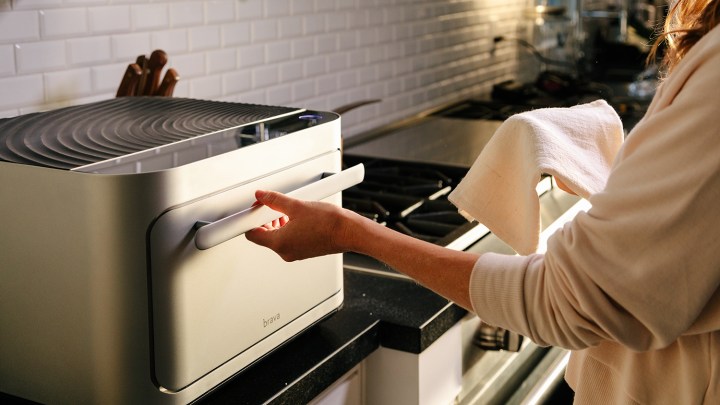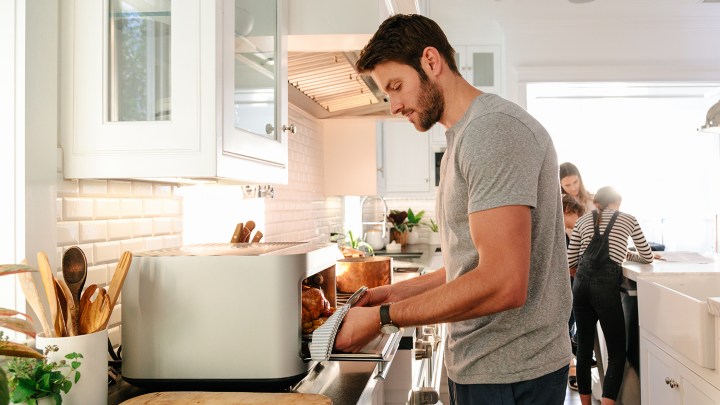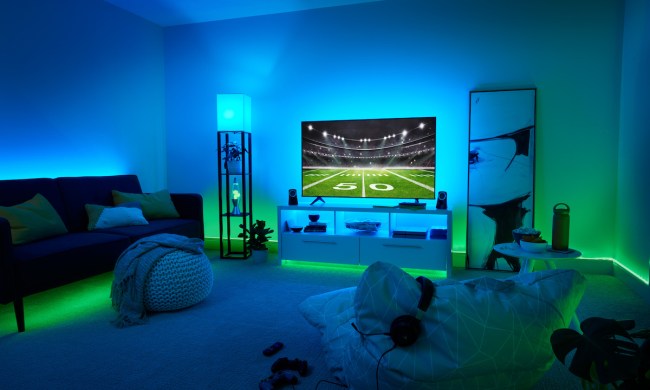
Forget building a better mousetrap: Thomas Cheng and John Pleasants built a better oven, reimagined from the ground up to be smarter, faster, and better, just like the Six Million Dollar Man. And to prove it, they just served me a mouthwatering dinner of seared salmon, asparagus, and roasted tomatoes — cooked to absolute perfection in about six minutes at the press of a single button. The Brava Pure Light Oven cooks not with magic (though it sure seemed like it at first) but with infrared light, a technology Cheng spent years dreaming up and perfecting in his garage.
Well, maybe not Thomas himself.
“It’s actually kind of [co-founder Dan Yue’s] mom that’s the originator of the idea,” Pleasants told me. Six years ago, around Christmas time, Yue and his family were sitting around the kitchen table watching his mom prep dinner and wondering why cooking was so time consuming. Did she really have to run back and forth into the kitchen? Is cooking really that cumbersome? (Answer: yes.)
“We cook the food much faster, without heating the air as much, and without heating the oven as much.”
“After debating things like android robots and stuff like that, they said, if the oven itself was simply smart enough to know when to turn off and on and to know what was in it, that would be update enough. And so there’s the smart oven idea,” Pleasants told Digital Trends.
But the Brava is more than just a smart oven, and the tech is more than just a sensor or two, he explained.
“It’s really just [Cheng] in the garage for nine or 10 months, tearing apart toaster ovens, playing with these different heating elements,” he said. The inspiration: the industrial segment, where giant commercial ovens that cost millions burn silicon onto solar panels. Those machines take vast amounts of power, and they’re capable of melting down metal pots in seconds.
“He sees this and thinks, wow, light can be actually that powerful,” Pleasants said. “How do I tailor and build these bulbs so that they’re conducive to [the kitchen]?”
How indeed.

Behind the Bulbs
Cheng honed that commercial technology, harnessing infrared light for the six highly specialized lightbulbs in the top and bottom of the Brava; each can be controlled thousands of times per second, and the Brava can fine-tune the wavelength of light its bulbs emit. Longer wavelengths penetrate deeper into foods, and shorter ones hit the edges or only heat trays or racks.
By aiming the light at a specific spot in a piece of food, it can be cooked much faster than with a regular oven. Put in a glass cooking tray and the bulbs can turn it into a fry pan, creating the perfect sear on salmon or steak. Switch the bulbs back and forth between these modes countless times per second and you’ve got a brand new way of cooking.
Cooking with light means transferring energy directly to the food itself, rather than the space around it or the pan it’s sitting in, which translates into vastly more efficient and faster cooking. I’ll let Brava’s website explain it: “We adjust the frequency of light waves in real time to cook the interior and exterior of foods independently, allowing intense sears on the outside while preserving inner doneness and delicate flavors.”
Brava can cook your food in less time, without your attention, and here’s the kicker: it should do it perfectly every time.
Mark it down as the magic of physics (although “it’s hardly black magic,” Cheng told me) and concentrate on the food. Ever seared food in an oven? It usually takes place in a skillet or griddle on the top of the stove, with much spattering of grease and oil, and it takes 10 to 15 minutes to heat a cast-iron skillet to a good temperature for cooking. Brava can cook your food in less time, without your attention, and here’s the kicker: it should do it perfectly every time.
It’ll also monitor the cooking temperature precisely, thanks to an incredibly fancy custom thermometer the company built. Called the TempSensor, it has five detection points to measure how food is cooking throughout, not just at any one given point. You really only need it for thicker proteins like steaks and fish.
Put all that together and you’ve got a fascinating product. But that’s not even the crazy part.
The Great Toast Conundrum
Everything about the Brava is mind blowing – but nothing more so than the challenges presented by toast. Let me tell you a little about power, which is far from consistent across power sources. Hydro electric power, solar power, nuclear power, all supply energy to your house at different levels. These differences are small enough that they won’t make a difference to your hair dryer or electric range, but those infinitesimal characteristics mess up the Brava’s lightbulbs. This oven needs to very precisely control the wavelength of light, remember? And light that’s a shade darker in one spot means, for example, that toast won’t toast the same way depending on your power source.
And that’s no good, because obviously.
“You can’t have toast cooked in Queens come out differently than toast in Brooklyn, right?”
“You can’t have toast cooked in Queens come out differently than toast in Brooklyn, right?” Pleasants asked. To prevent that, the company found a way to measure the power coming into the unit to ascertain what sort of power it is receiving and fine tune the light waves created for it. Crazy, right?
The custom TempSensor is crazy too: It’s probably the most sensitive food thermometer ever built, made in Switzerland from insanely costly materials, including gold and platinum. All of this means the Brava isn’t going to be cheap. When available this November, it will cost $995, and a “Chef’s Choice” edition with a special set of cookware and extra accessories will go for $1,295.
Pleasants wants to get the cost down to $500 at some point, but for now, he’s confident there will be a market. He wants you to forget about costly tech cooking gadgets that have struggled or even flopped in recent years, such as the widely ridiculed $700 Juicero juicemaker, an obviously wrongheaded take on countertop appliances.
And forget the June smart oven, which Fast Company called “everything that’s wrong with Silicon Valley.” Brava is really more akin to Peloton, the in-home workout apparatus that’s taken the cycling world by storm. Essentially SoulCycle in the comfort of your own home, Peloton bikes are pricey and arguably a niche product. The company is nevertheless incredibly successful, and it shows no signs of slowing down – Peloton just unveiled a new treadmill, after all.
Could the Brava Pure Light Oven command a similar premium price and gain such fame? I know I’m a fan – and I’ve just eaten one meal. And the value proposition is clear: “We cook the food much faster, without heating the air as much, and without heating the oven as much,” explained Cheng. “A meal for two – protein, carbs, and veggies, all on one tray – and it uses less energy than it takes to pre-heat an oven.”
Shut up and take my money — and pass the salmon.









